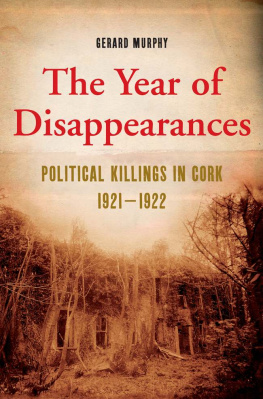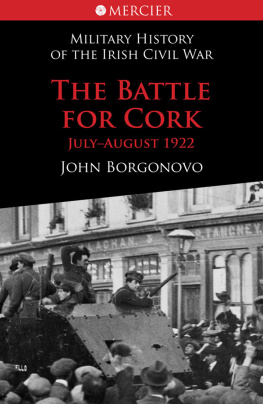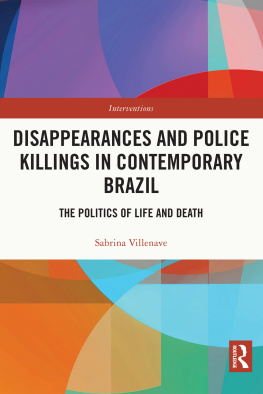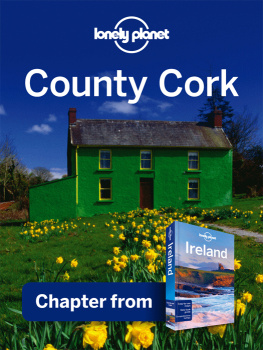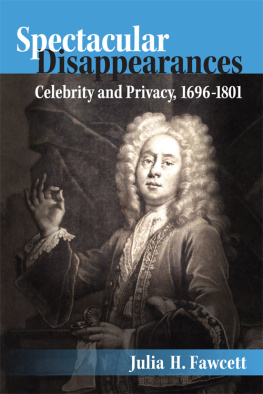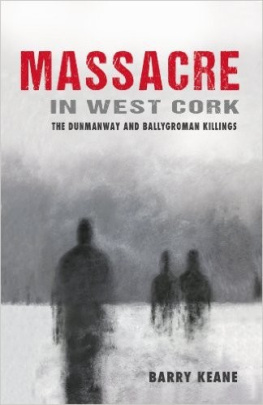 | THE YEAR OF
DISAPPEARANCES |
| Political Killings in Cork, 19211922 |
SECOND EDITION |
GERARD MURPHY  |
Gill & Macmillan |
Dedicated to the memory of Eugene Turpin (19262006)
CONTENTS
PREFACE TO THE SECOND EDITION
O n its publication in 2010 The Year of Disappearances was the subject of significant controversy. This is not surprising given that the War of Independence period, though 90 years in the past, is still a contentious subject and there are many people both inside and outside of academic circles with strong views on how this period of Irish history is portrayed and interpreted. Much of the criticism directed at the book thus far was either of a peripheral or semantic nature and had little bearing on the main contents of the bookat least not in the eyes of reasonable persons reading it. However, history is a collaborative process and proceeds by a process of correction. I have, therefore, in this edition corrected any errors in the text that have been brought to my attention since the book was first published. I have also, insofar as I could, addressed various issues raised by providing additional information which I had not included in the first edition. Since the book originally went to print I have uncovered new material that I hope helps to clarify some issues which, due to pressure of deadlines, I was not able to include at the time.
Gerard Murphy
14 April 2011
PREFACE TO THE FIRST EDITION
I n the autumn of 2003 I submitted a novel to several Irish publishers. The book, which detailed the operation of a sort of killing field operated by the IRA on the outskirts of Cork during the War of Independence, was well received, yet did not find a publisher. However, one well-respected publisher called me up and asked to meet with me. Surely, she said, after she had established that the story was true in its essentials, you dont expect to get away with this? By this she meant that, though she liked the novel, it was none the less a work of fiction and would lead to as many questions as it would answers. Was it true that the IRA was rounding up teenagers on the streets of Cork in 1921 and executing them as spies? When I said that, as far as I could establish, it was true, she said I had little choice but to write a non-fiction account of these events.
This entailed a lot of further researchthe novel had been based on the version of events left by old Cork IRA men who had lived into the 1960s and 70s. I had no independent verification of these events at the time. The result of this search is what is to be found within the covers of this book. It does not claim to be the last word on these events. It is rather a summary of the evidence for the secret killings that took place in Cork city during the years of the revolution, not just during the War of Independence but right through the Civil War. It is the best I could do with what I uncovered, and some conclusions may turn out to be incorrect when more evidence becomes available. It is at best a theory or, rather, a series of interrelated theories. These may be refuted by future scholars. If so, good luck to them.
This is a dark part of Irish history and it has suited various interests to keep quiet about it for the best part of a century. However, all the events described here took place, some of them in the area in which I myself was brought up. What is less certain is the precise motivation behind many of the killings. History at a microscopic level is always a lot more complex than it might appear on superficial examination. War, even a war as limited and circumscribed as the Irish revolution, is an environment in which men (and occasionally women) are capable of doing almost anything. Hate is something that cannot be measured and is often unfathomable to those of us who are lucky enough to live in times and environments that are free of conflict. It is therefore difficult and probably unfair to judge what people did in times when extreme behaviour was the order of the day. War is a phenomenon from which very few protagonists emerge smelling of roses. None the less, whether we like it or not, to write history is in effect to sit in judgment on the past. History is not a chemical that can be assayed in a lab; it is made of human failure and pettiness, just as it can sometimes be made of the most extraordinary acts of self-sacrifice and bravery.
There were many times during the writing of this book when I felt that it might be better to let sleeping dogs lieoften in this instance in their anonymous and unmarked graves. There will be people who will be unhappy with this book because it opens up some of the deep divisions inherent in this as in any society. For people in conflict situations do things for all kinds of complex motivations. There is only one reason for publishing a book like this one: it is what happened; these are the facts, even if the truth is a much more elusive quarry than what can be reconstructed from mere facts. It was a very difficult book to write mainly because it suited everybody concerned to either lie about what happened, or cover it all up.
The reality is that during the early 1920s scores of peopleat least 50 and probably many morewent missing in Cork city and the surrounding areas, executed by the IRA for various crimes against the Republic. In most of these cases their families were never to receive any information as to the fate of their loved ones. In many instances the families themselves colluded in the silence out of fear because to do otherwise would bring the ultimate sanction on other family members, as indeed sometimes happened. These killings were in most cases forgotten about eventually because in order to live in the new order of the Free State it was best to say nothing about the past and bury it along with the dead. Even the nascent state colluded in this silence since it was often less than helpful, for reasons of respectability and not wanting to let the side down, when relatives wrote concerning what had happened to the victims. And some there be, which have no memorial; who are perished, as though they had never been. (Ecclesiasticus) This is the story of a few of them.
We buried the bodies in Carrolls Bogs. Every spy who was shot in Cork was buried so that nothing was known about them. They just disappeared. |
MICK MURPHY O/C 2ND BATTALION, CORK NO I BRIGADE, IRA |
 | PART I |
Chapter 1  |
| THE MYSTERIOUS DEATH OF GEORGE TILSON |
O n 19 February 1921, as the mail train from Fishguard pulled into Paddington, a man called Fred Jones, an electrician employed by the Great Western Railway Company, was surprised to find one of the toilet doors locked. He heard groans coming from inside and then he heard a thud as if someone had fallen. When the door was finally forced open, he found a dying man slumped against the toilet. There was blood all over the floor. The mans throat had been cut. He was still alive, though unable to speak. He pointed towards his coat pocket, indicating to Jones to take out what was inside. In the pocket Fred Jones found a note that read: I have been shadowed all the way from Cork, but they shall not get me. The man was taken to St Marys Hospital where he died without making a statement.
The mans name was George Frederick Tilson, a 36-year-old pawnbroker from Cork and, though there was a suggestion that he had been murdered, the inquest into his death found that he had slit his own throat and the reason was stated in the envelope in his pocket: not to be done in by them. For them, the men who he believed had followed him from Cork, were members of the Cork No. 1 Brigade of the IRA, though there is no evidence that they had actually done so.
Next page
